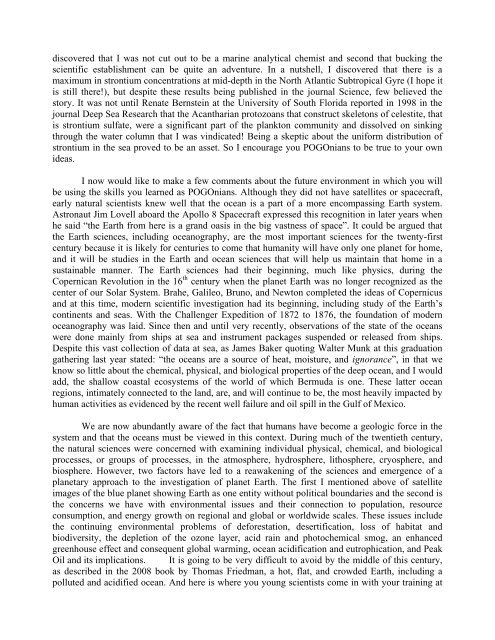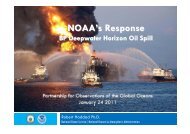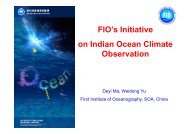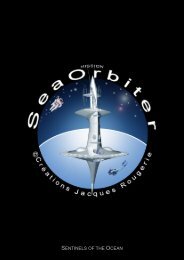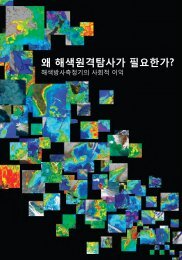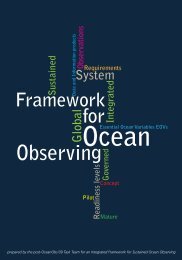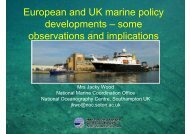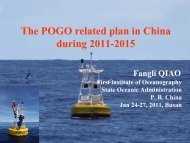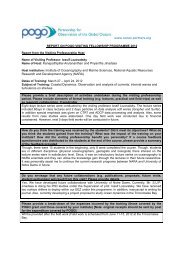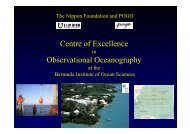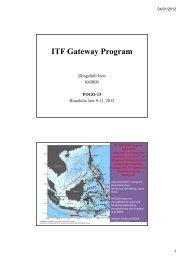NF-POGO Centre of Excellence Year 2 Report
NF-POGO Centre of Excellence Year 2 Report
NF-POGO Centre of Excellence Year 2 Report
- No tags were found...
Create successful ePaper yourself
Turn your PDF publications into a flip-book with our unique Google optimized e-Paper software.
discovered that I was not cut out to be a marine analytical chemist and second that bucking thescientific establishment can be quite an adventure. In a nutshell, I discovered that there is amaximum in strontium concentrations at mid-depth in the North Atlantic Subtropical Gyre (I hope itis still there!), but despite these results being published in the journal Science, few believed thestory. It was not until Renate Bernstein at the University <strong>of</strong> South Florida reported in 1998 in thejournal Deep Sea Research that the Acantharian protozoans that construct skeletons <strong>of</strong> celestite, thatis strontium sulfate, were a significant part <strong>of</strong> the plankton community and dissolved on sinkingthrough the water column that I was vindicated! Being a skeptic about the uniform distribution <strong>of</strong>strontium in the sea proved to be an asset. So I encourage you <strong>POGO</strong>nians to be true to your ownideas.I now would like to make a few comments about the future environment in which you willbe using the skills you learned as <strong>POGO</strong>nians. Although they did not have satellites or spacecraft,early natural scientists knew well that the ocean is a part <strong>of</strong> a more encompassing Earth system.Astronaut Jim Lovell aboard the Apollo 8 Spacecraft expressed this recognition in later years whenhe said ―the Earth from here is a grand oasis in the big vastness <strong>of</strong> space‖. It could be argued thatthe Earth sciences, including oceanography, are the most important sciences for the twenty-firstcentury because it is likely for centuries to come that humanity will have only one planet for home,and it will be studies in the Earth and ocean sciences that will help us maintain that home in asustainable manner. The Earth sciences had their beginning, much like physics, during theCopernican Revolution in the 16 th century when the planet Earth was no longer recognized as thecenter <strong>of</strong> our Solar System. Brahe, Galileo, Bruno, and Newton completed the ideas <strong>of</strong> Copernicusand at this time, modern scientific investigation had its beginning, including study <strong>of</strong> the Earth‘scontinents and seas. With the Challenger Expedition <strong>of</strong> 1872 to 1876, the foundation <strong>of</strong> modernoceanography was laid. Since then and until very recently, observations <strong>of</strong> the state <strong>of</strong> the oceanswere done mainly from ships at sea and instrument packages suspended or released from ships.Despite this vast collection <strong>of</strong> data at sea, as James Baker quoting Walter Munk at this graduationgathering last year stated: ―the oceans are a source <strong>of</strong> heat, moisture, and ignorance‖, in that weknow so little about the chemical, physical, and biological properties <strong>of</strong> the deep ocean, and I wouldadd, the shallow coastal ecosystems <strong>of</strong> the world <strong>of</strong> which Bermuda is one. These latter oceanregions, intimately connected to the land, are, and will continue to be, the most heavily impacted byhuman activities as evidenced by the recent well failure and oil spill in the Gulf <strong>of</strong> Mexico.We are now abundantly aware <strong>of</strong> the fact that humans have become a geologic force in thesystem and that the oceans must be viewed in this context. During much <strong>of</strong> the twentieth century,the natural sciences were concerned with examining individual physical, chemical, and biologicalprocesses, or groups <strong>of</strong> processes, in the atmosphere, hydrosphere, lithosphere, cryosphere, andbiosphere. However, two factors have led to a reawakening <strong>of</strong> the sciences and emergence <strong>of</strong> aplanetary approach to the investigation <strong>of</strong> planet Earth. The first I mentioned above <strong>of</strong> satelliteimages <strong>of</strong> the blue planet showing Earth as one entity without political boundaries and the second isthe concerns we have with environmental issues and their connection to population, resourceconsumption, and energy growth on regional and global or worldwide scales. These issues includethe continuing environmental problems <strong>of</strong> deforestation, desertification, loss <strong>of</strong> habitat andbiodiversity, the depletion <strong>of</strong> the ozone layer, acid rain and photochemical smog, an enhancedgreenhouse effect and consequent global warming, ocean acidification and eutrophication, and PeakOil and its implications. It is going to be very difficult to avoid by the middle <strong>of</strong> this century,as described in the 2008 book by Thomas Friedman, a hot, flat, and crowded Earth, including apolluted and acidified ocean. And here is where you young scientists come in with your training at


